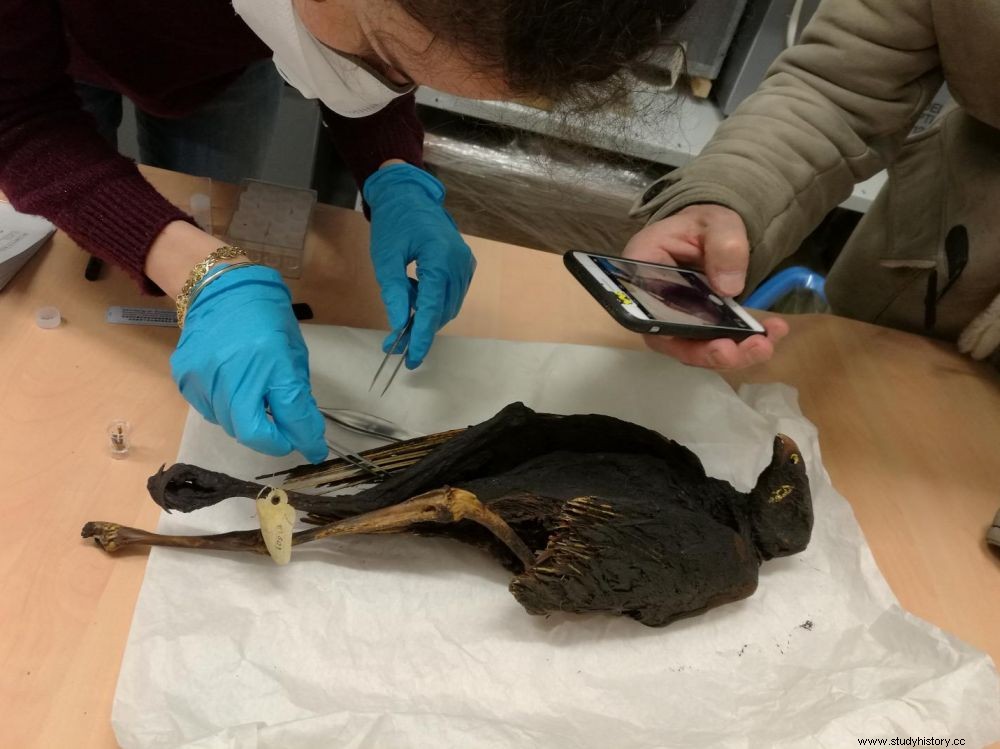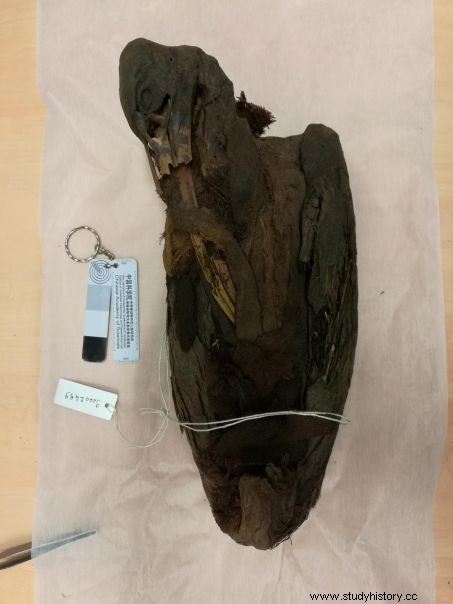Geochemists and archaeologists have analyzed bird mummies found in astronomical proportions in the necropolises of the Late Egyptian period. The objective:to find out if these animals had been the subject of intensive breeding, like cats, or if they had been taken from their natural environment.

Marie Linglin samples a mummified ferocious buzzard specimen at the Musée des Confluences in Lyon.
Did the ancient Egyptians keep birds for their ritual practices like they did cats? The enormous number of ibises and raptors discovered in the necropolises of the Nile Valley - small mummies are estimated to number in the tens of millions! - has long raised the question of their provenance. Sacrificed and deposited as an offering to the gods Horus, Re or Thoth, these birds, by their number, could only play a major role in the economy of the Egyptian Late period, from the 7th century before our era, until the 3rd century of our era.
Two hypotheses have coexisted so far, without one ever being able to take precedence over the other:either these animals were bred specifically for this votive use, or they were hunted en masse in their natural environment. Deciding in favor of one or the other would in any case make it possible to obtain crucial information on the organization of ancient Egyptian society before its decline under Roman domination.
Researchers from CNRS, Université Claude Bernard Lyon 1 and C2RMF1 had the opportunity to perform measurements on fragments of feathers, bones and embalming strips from 20 ibis and raptor mummies , all kept at the Musée des Confluences in Lyon. According to their results, published on September 22, 2020 in Scientific Reports , these birds were indeed wild.
Food past
To make their mummies speak, Romain Amiot, geochemist at the Lyon Geology Laboratory:Earth, planets and environment, and doctoral student in anthropology Marie Linglin, started from a simple principle:if the birds were farmed, they had to necessarily ingest food produced specifically or derived from that of humans of the same period, and drink water with the isotopic signature specific to the Nile Valley. In the same logic, their dietary variability had to be equal to or less than that of their breeders.
Did the ancient Egyptians keep birds for their ritual practices like they did cats? The enormous number of ibises and raptors discovered in the necropolises of the Nile Valley - small mummies are estimated to number in the tens of millions! - has long raised the question of their provenance. Sacrificed and deposited as an offering to the gods Horus, Re or Thoth, these birds, by their number, could only play a major role in the economy of the Egyptian Late period, from the 7th century before our era, until the 3rd century of our era.
Two hypotheses have coexisted so far, without one ever being able to take precedence over the other:either these animals were bred specifically for this votive use, or they were hunted en masse in their natural environment. Deciding in favor of one or the other would in any case make it possible to obtain crucial information on the organization of ancient Egyptian society before its decline under Roman domination.
Researchers from CNRS, Université Claude Bernard Lyon 1 and C2RMF1 had the opportunity to perform measurements on fragments of feathers, bones and embalming strips from 20 ibis and raptor mummies , all kept at the Musée des Confluences in Lyon. According to their results, published on September 22, 2020 in Scientific Reports , these birds were indeed wild.
Food past
To make their mummies speak, Romain Amiot, geochemist at the Lyon Geology Laboratory:Earth, planets and environment, and doctoral student in anthropology Marie Linglin, started from a simple principle:if the birds were farmed, they had to necessarily ingest food produced specifically or derived from that of humans of the same period, and drink water with the isotopic signature specific to the Nile Valley. In the same logic, their dietary variability had to be equal to or less than that of their breeders.

Mummified sacred ibis from the Egyptology collections of the Musée des Confluences in Lyon. Credits:Romain Amiot/LGL-TPE/CNRS
Romain Amiot and Marie Linglin thus sent the micro-fragments taken from the remains of sacred ibises and from a ferocious buzzard to the Center for Investigation and Research on Mummies, in Paris, where isotopic measurements of the oxygen, carbon, Nitrogen, sulfur and strontium, classic in environmental archaeology, have made it possible to trace the food history of these birds. These were found to exhibit much greater isotopic variability than those of the ancient Egyptians, with the presence of "exotic" signatures. "These birds moved freely in this vast valley and went up to the sources of the Nile according to the seasons" , explains Romain Amiot to Sciences et Avenir . "In short, we immediately had a good conclusion, unequivocal:they were chased."
Ecological pressure
In 2019, a study by paleogeneticist Sally Wasef showed in mummified ibises the genetic diversity typical of a species living in the wild. "Our results are therefore very much in line with those of Sally Wasef" , continues Romain Amiot. Although rare, some bas-reliefs and papyri also testify to this practice of hunting, probably carried out with large nets and not with arrows. This is the case of a wall in the tomb of Nakht, in the Theban necropolis. "Many of the mummified birds appear to have had their necks twisted, which is consistent with a net hunt."
Such intensive hunting, over several centuries, undoubtedly exerted tremendous ecological pressure on wild bird populations, long before the declines in avifauna observed today. "Yet it was not until the middle of the 19th century that the wild ibis began to see its population decline, so one can now wonder how they managed to survive and adapt in the face of a such a threat."
